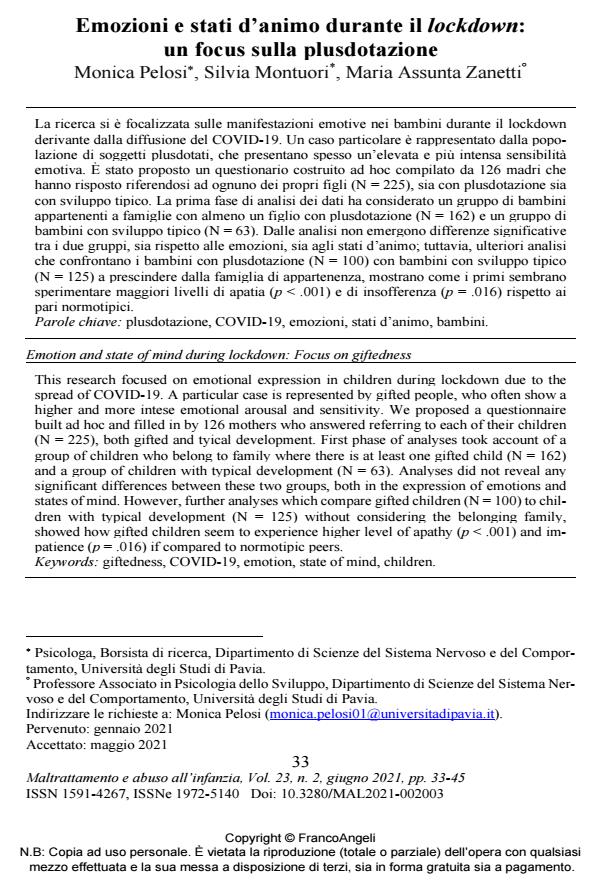Emozioni e stati d’animo durante il lockdown: un focus sulla plusdotazione
Titolo Rivista MALTRATTAMENTO E ABUSO ALL’INFANZIA
Autori/Curatori Monica Pelosi, Silvia Montuori, Maria Assunta Zanetti
Anno di pubblicazione 2021 Fascicolo 2021/2
Lingua Italiano Numero pagine 13 P. 33-45 Dimensione file 168 KB
DOI 10.3280/MAL2021-002003
Il DOI è il codice a barre della proprietà intellettuale: per saperne di più
clicca qui
Qui sotto puoi vedere in anteprima la prima pagina di questo articolo.
Se questo articolo ti interessa, lo puoi acquistare (e scaricare in formato pdf) seguendo le facili indicazioni per acquistare il download credit. Acquista Download Credits per scaricare questo Articolo in formato PDF

FrancoAngeli è membro della Publishers International Linking Association, Inc (PILA)associazione indipendente e non profit per facilitare (attraverso i servizi tecnologici implementati da CrossRef.org) l’accesso degli studiosi ai contenuti digitali nelle pubblicazioni professionali e scientifiche
La ricerca si è focalizzata sulle manifestazioni emotive nei bambini durante il lockdown de-rivante dalla diffusione del COVID-19. Un caso particolare è rappresentato dalla popola-zione di soggetti plusdotati, che presentano spesso un’elevata e più intensa sensibilità emo-tiva. È stato proposto un questionario costruito ad hoc compilato da 126 madri che hanno risposto riferendosi ad ognuno dei propri figli (N = 225), sia con plusdotazione sia con svi-luppo tipico. La prima fase di analisi dei dati ha considerato un gruppo di bambini apparte-nenti a famiglie con almeno un figlio con plusdotazione (N = 162) e un gruppo di bambini con sviluppo tipico (N = 63). Dalle analisi non emergono differenze significative tra i due gruppi, sia rispetto alle emozioni, sia agli stati d’animo; tuttavia, ulteriori analisi che con-frontano i bambini con plusdotazione (N = 100) con bambini con sviluppo tipico (N = 125) a prescindere dalla famiglia di appartenenza, mostrano come i primi sembrano sperimentare maggiori livelli di apatia (p < .001) e di insofferenza (p = .016) rispetto ai pari normotipici.
Parole chiave:plusdotazione, COVID-19, emozioni, stati d’animo, bambini.
- The Influence of Gifted Children’s Stress Management on Parental Stress Levels Maria Assunta Zanetti, Francesca Sangiuliano Intra, Livia Taverna, Antonella Brighi, Carlo Marinoni, in Children /2024 pp.538
DOI: 10.3390/children11050538
Monica Pelosi, Silvia Montuori, Maria Assunta Zanetti, Emozioni e stati d’animo durante il lockdown: un focus sulla plusdotazione in "MALTRATTAMENTO E ABUSO ALL’INFANZIA" 2/2021, pp 33-45, DOI: 10.3280/MAL2021-002003